Skansbukta
[78° 31.5' N 16° 02' E]
By Øystein Overrein (ed.), Jørn Henriksen, Bjørn Fossli Johansen, Kristin Prestvold
Skansbukta, which is in the outer part of Billefjorden, is located in a bay which is protected from winds from most directions. Under the impressive cliffs of Skansen there is a narrow beach terrace with a cabin. North of the cabin there are remains from the gypsum mine that once was active here. On the green slope behind the cabin you will find treasures not found in many other places in Svalbard – thermophilic flora characteristic for the inner parts of Isfjorden.
Take care:
- Installations and objects dating from the mining, and also the trapper’s cabin on the opposite side of the bay, are all protected cultural remains.
- If there are people in the cabin; make appointments. Groups of tourists must keep away from the area round the cabin.
- Do not walk up the scree slope to the base of the cliff. There is danger of rock falls and it creates unnecessary erosion.
- It is prohibited to pick flowers.
- Do not enter the historic trappers’ cabin on the south-west side of the bay.
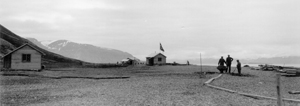
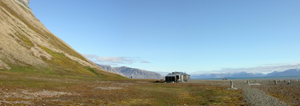 Buildings at Skansbukta, before and now. (Images: over: Wilhelm Solheim / Norwegian Polar Institute, under: Jørn Henriksen) Buildings at Skansbukta, before and now. (Images: over: Wilhelm Solheim / Norwegian Polar Institute, under: Jørn Henriksen)
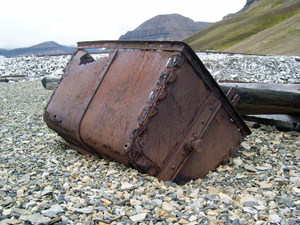 A wagon that was pushed between the mine and the lading plant is lying beside its narrow gauge railway that was placed on top of a land filling of gypsum and anhydrite. (Image: Jørn Henriksen) A wagon that was pushed between the mine and the lading plant is lying beside its narrow gauge railway that was placed on top of a land filling of gypsum and anhydrite. (Image: Jørn Henriksen)
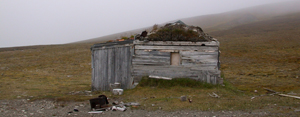 The satellite station built by Oxaas and Ullsfjord on the south-west side of Skansbukta. (Image: Jørn Henriksen) The satellite station built by Oxaas and Ullsfjord on the south-west side of Skansbukta. (Image: Jørn Henriksen)
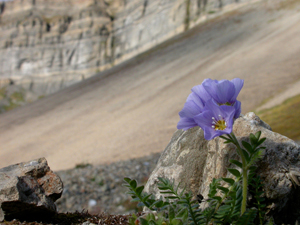 The popular name of this flower, boreal Jacob’s-ladder, is referring to the dream of the biblical Jacob where the angels climbed down and up again to Heaven on a ladder. The blades are the ladders and the flower is Heaven. (Image: Jørn Henriksen) The popular name of this flower, boreal Jacob’s-ladder, is referring to the dream of the biblical Jacob where the angels climbed down and up again to Heaven on a ladder. The blades are the ladders and the flower is Heaven. (Image: Jørn Henriksen)
 The wreck of a barge from mining operations located on the beach under Skansen. (Image: Kristin Prestvold / Sysselmannen på Svalbard) The wreck of a barge from mining operations located on the beach under Skansen. (Image: Kristin Prestvold / Sysselmannen på Svalbard)
In a lush and beautiful landscape, under the mountain Skansen, there are many different remains of earlier human activity. The area is a perfect example of how cultural remains and landscape are closely tied together. In Skansbukta you can easily get an impression of how humans interacted with, and left traces in, the landscape.
The beach and the slope under the mountain Skansen are littered with cultural remains from two periods of mineral exploration and exploitation during the 20th century. The attractive mineral here was gypsum and the findings created much attention in the years before World War I. In 1918 Dalen Portland Cementfabrikk from Brevik, Norway, occupied the area and started exploring. The venture became short-lived and the activity was terminated after one season.
The gypsum mine was re-opened by ship owner Kjøde in the 1930s, but after a few years of trial operation the activity was again stopped. Today you will find many remains from the mining for gypsum in Skansbukta – most of them from the second period. There are remains from the lading plant on large landfills of gypsum and anhydrite. The entry to the gallery is low in the slope and has a narrow gauge railway towards the beach where the tip was. Incomplete parts of the railway which was split into several tracks and large ramps made out of coarse timber are probably the remains from the laden plant. There are other remains from the smithy, the workshop and toilet, but also a house site that probably functioned as the workers barrack and mess. Further up the beach there is a boat with a wheelhouse, a cargo hold and an engine. It is worn from the weather, but in relatively good shape.
Between the larger structures in the landscape there are smaller things that tell you something about daily life and the humans that once lived and worked here; the remains of wagons that were used to transport the gypsum from the gallery, rusty nails and cans, broken glass and bottles. The tale about the many mineral ventures in Svalbard and the dream about a quick profit are present also in Skansbukta.
The remains from the mining in Skansbukta show signs of the ravages of time. Slowly they disintegrate and they are supposed to “die in beauty”. Nature takes back its land; these are natural processes of which it is neither practical nor wanted to do anything about. Being a visitor in Skansbukta it is important not to accelerate the disintegration process by stepping and crumpling items or picking souvenirs. The remains from previous human activity are supposed to lie untouched.
The south west side of the bay has remains from the Norwegian overwintering trapping from the beginning of the 20th century. In the area there is a trapper’s cabin, a house site and a grave. The site and the grave are connected and bear witness to the overwintering of trapper Peder Nilsen Furfjord from 1904-1905. Furfjord had previously overwintered a few times in Isfjorden when he decided to make another one together with his wife Hansine and his two brothers Simon and Mathias. During the winter Hansine got ill and died. Her grave is found on the moraine-ridge a bit up the slope from the site of the timber cabin they resided in. The death of Hansine struck Peder hard and he never overwintered again. The cabin is long gone, but the grave is still visible. On the cross you can still read parts of its inscription:
…rests Hansine Nilsen Furfjord. Born 1850 died the 22nd MA…
Furthest out on the same side of the bay there is another trapper’s cabin, probably built as a satellite station in 1923 by Arthur Oxaas and Peder Pedersen Ullsfjord. According to the diary of Oxaas from 1938 he later bought the cabin from the widow of Ullsfjord and repaired it. The cabin is, true to tradition, built of materials at hand. Some is driftwood and some is probably snatched from the installations across the bay. This is in line with the Arctic tradition of re-using building materials. The Governor of Svalbard has restored the cabin.
Vulnerable elementsThe site is littered with cultural remains and you have to be careful where you step. There is also a danger of erosion if you are walking up the lush slope behind the cabin. Landing sitesIt is an easy landing in Skansbukta. The anchorage is good and it is a short way in with the landing craft. The landing site is right by the cabin on the north-east side of the bay. It is a pebble beach and it is quite steep. Be aware of cultural remains on the beach and avoid stepping on them in the process of going ashore. Recommended trailsFrom the cabin the overview of the beach is good and it is a site that can fit larger groups. An armed guide placed by the cabin will have a good overview in the direction of Billefjorden and an armed guide at the boat wreck will have a good overview towards the end of the bay. In the slope there are large communities of boreal Jacob’s-ladder (Polemonium boreale). The flowering season is short, but in July and the beginning of August there is a good chance of seeing this beautiful blue flower. A visit in Skansbukta is combinable with a landing to take a look at the cultural remains from the Norwegian overwintering period. The old cabin that used to belong to Arthur Oxaas is easily available and it is authentic following repairs done by the Governor of Svalbard. You can also do a small boat cruise out to Kapp Fleur de Lys where the gypsum stratum is showing. Up the cliff above the gypsum stratum there is a small colony of Atlantic puffins. Often there are birds on the water and sometimes they are very curious of small boats.
|